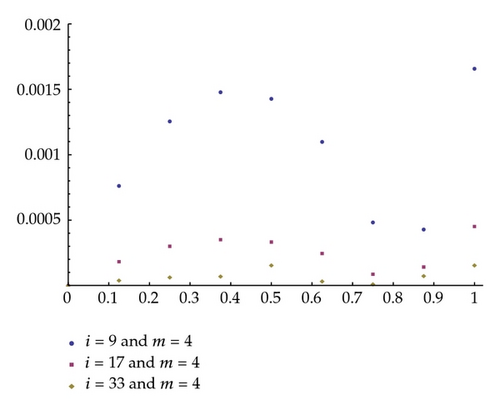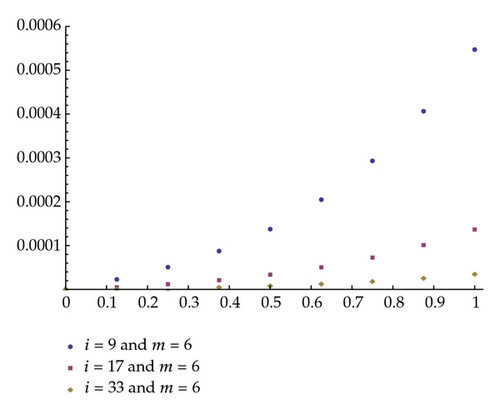Fixed-Point Iterative Algorithm for the Linear Fredholm-Volterra Integro-Differential Equation
Abstract
With the aid of fixed-point theorem (an equivalent version for the linear case) and biorthogonal systems in adequate Banach spaces, the problem of approximating the solution of a linear Fredholm-Volterra integro-differential equation is turned into a numerical algorithm, so that it can be solved numerically.
1. Introduction
Observe that if k1(t, s) = 0 and f(t) = 0 in (1.1), the equation is transformed into a linear Volterra integro-differential equation; and if k2(t, s) = 0 and f(t) = 0, it becomes a linear Fredholm integro-differential. Additionally, if k1(t, s) = k2(t, s) = 0, (1.1) is transformed into a linear differential equation of the first order.
Frequently the mathematical modelling of problems arising from the real world (see [1] and the references therein) deals with problem (1.1). These are usually difficult to solve analytically, and in many cases, the solution must be approximated. Therefore, in recent years, several numerical approaches have been proposed (see, e.g., [2–4]). The numerical methods usually transform the integro-differential equation into a linear system that can be solved by direct or iterative methods. On the other hand, the use of fixed-point techniques in the numerical study of linear differential, integral, and integro-differential equations has also proven successful in some works, as [5–11]. The purpose of this paper is to develop an effective method for approximating the solution of (1.1) using Schauder basis and another classical tool in analysis: an equivalent version of the fixed-point theorem for the linear case (the geometric series theorem). This algorithm generalizes the developed ones in [7, 8, 10] for Volterra integro-differential, Fredholm integro-differential, and differential equation, respectively.
To establish our numerical method, we first need to review some results of a theoretical nature in Section 2. We arrive at a numerical method for approximating the solution of (1.1) in Section 3, and in order to state the results about convergence and to study the error of the proposed algorithm, we will assume that γ = ∥f∥+∥k1∥+∥k2∥/2 < 1 and k1, k2 ∈ C1([0,1] 2) and f, g ∈ C1([0,1]). Finally, in Section 4, we illustrate the theoretical results with two examples.
2. Two Tools of a Theoretical Nature
Two fundamental tools will be used to establish the algorithm needed to solve the problem (1.1). The first is the following equivalent version (for the linear case) of the Banach fixed-point theorem (see [12]).
Geometric Series Theorem Let X be a Banach space, and let T : X → X be a continuous and linear operator such that ∥T∥<1. Then, Id − T is a continuous, linear, and bijective operator and (Id − T) −1 = ∑n≥0 Tn.
In particular, given y ∈ X, the equation (Id − T)x = y has a unique solution x = (Id − T) −1y.
The second tool applied consists of biorthogonal systems in Banach spaces 𝒞([0,1]) and 𝒞([0,1] 2). We will make use of the usual Schauder basis for simplicity in the exposition, although the numerical method given works equally well by replacing it with any complete biorthogonal system in 𝒞([0,1] 2). For this reason, we will now briefly recall the main issues and notations regarding Schauder bases in 𝒞([0,1]) and 𝒞([0,1] 2).
- (a)
for all t, s ∈ [0,1], B1(t, s) = 1 and for n ≥ 2,
- (b)
if w ∈ C([0,1] 2), then , and for all n ≥ 2, if τ(n) = (i, j), ,
- (c)
the sequence of associated projections satisfies Qn(w)(ti, tj) = w(ti, tj), whenever n, i, j ∈ ℕ and τ−1(i, j) ≤ n,
- (d)
this Schauder basis is monotone, that is,
3. The Algorithm: Convergence and Error
It is a simple matter to check that a function x ∈ C1([0,1]) is the solution of (1.1) if and only if (Id − L)x = g, where .
We can then calculate iteratively using (3.5), at least in a theoretical way, the solution of (1.1). From a practical viewpoint, in general these calculations are not possible explicitly. The idea of our numerical method is to use an appropriate Schauder basis in the spaces 𝒞([0,1]), 𝒞([0,1] 2) truncating the functions of such spaces by means of the projections of the Schauder bases and , and replacing each Lym−1 (m ≥ 1) in (3.5) by a new function vm ∈ 𝒞([0,1]), easier to calculate, and in such a way that the error ∥x − (g + vm)∥ be small enough. Given these functions, each g + vm will be approximation of the solution of (1.1).
We will show that the sequence approximates the solution of (1.1) while in order to study the error , let us assume that k1, k2 ∈ C1([0,1] 2) and f, g ∈ C1([0,1]).
In the first place, we show the following.
Lemma 3.1. The sequences and are bounded.
Proof. First we show, using an inductive argument, that for all t ∈ [0,1], . Since the Schauder basis is monotone, we have
Suppose that the result holds for m − 1, in other words , and using the monotony of , we prove for m the following:
On the other hand, with similar arguments,
Remark 3.2. Given that for i ∈ {1,2} and m ∈ ℕ,
Theorem 3.3. With the previous notation, if m ∈ ℕ, with nj+1 ≥ 2 and M = sup {Mm} m∈ℕ, then
Proof. The triangle inequality gives . Because of the inequality (3.6), we have
And thus, applying (2.7), we obtain the following bound:
The proof is complete in view of the triangular inequality and of (3.6) and (3.16).
Remark 3.4 3.4. Under the hypothesis of Theorem 3.3, for all ε > 0, we can find m ∈ ℕ and positive integers n1, …, nm such that . Furthermore, since γ < 1 and the points of partition can be chosen such that h is as small as we desire, is as small as we desire, and (3.14) also provides a quota of the error committed when we approach x by .
Remark 3.5. It follows from Theorem 3.3 that the proposed method with the chosen Schauder bases has order of convergence one. This choice has been done by simplicity in the exhibition of the results, and it has allowed us to obtain satisfactory numerical results as we show in the following section. Nevertheless, by integrating the considered basis in 𝒞([0,1]) (and adding the one constant function), we obtain new bases of 𝒞([0,1]) and 𝒞([0,1] 2). Considering these bases, the order of convergence is 2. In general, integrating n + 1 times, we would obtain order of convergence n.
4. Some Numerical Example
We now turn our attention to show two numerical performance results. For each example, we have fixed the subset chosen for constructing the Schauder basis in 𝒞([0,1]) and in 𝒞([0,1] 2), specifically, t1 = 0, t2 = 1; and for n ∈ ℕ ∪ {0}, ti+1 = (2k + 1)/2n+1 if i = 2n + k + 1 where 0 ≤ k < 2n are integers. To define the sequence , we take nj = i (for all j ≥ 1). In addition we include, a table exhibiting, for i = 9,17, and 33, the absolute errors committed for certain representative points of [0,1] when we approximate the exact solution x(t) by means of the iteration where m is shown in the table. The algorithms associated with the numerical method were performed using Mathematica 7. We have checked that when more points are used, the accuracy improves significantly, unlike the number of iterations.
- (1)
we introduce the nodes; we construct the base {bn} and the base {Bn},
- (2)
we calculate g (if it is not possible to explicitly arrive at g, we can apply a quadrature method),
- (3)
we define v0(t) = 0 and ,
- (4)
we calculate and using the base {bn} and , , , and using the base {Bn}. Note that we calculate the projections by integrals of piecewise univariate and bivariate polynomials of degrees 1 and 2 and the calculation of the coefficients of such polynomials just requires linear combinations of several evaluations of the basic functions at adequate points. We do not have to solve systems of algebraic equations,
- (5)
we calculate the expression using Definition (3.8),
- (6)
repeat the process.
Example 4.1. For the first example, we consider the following linear Fredholm-Volterra integro-differential equation with the exact solution x(t) = t2. Its numerical results are given in Table 1 and Figure 1:
| t | i = 9 | i = 17 | i = 33 |
|---|---|---|---|
| 0.125 | 7.63E − 4 | 1.84E − 4 | 4.04E − 5 |
| 0.250 | 1.25E − 3 | 3.02E − 4 | 6.42E − 5 |
| 0.375 | 1.47E − 3 | 3.52E − 4 | 7.12E − 5 |
| 0.5 | 1.42E − 3 | 3.35E − 4 | 6.11E − 5 |
| 0.625 | 1.10E − 3 | 2.47E − 4 | 3.36E − 5 |
| 0.750 | 4.84E − 4 | 8.88E − 5 | 1.15E − 5 |
| 0.875 | 4.30E − 4 | 1.44E − 4 | 7.47E − 5 |
| 1 | 1.65E − 3 | 4.54E − 4 | 1.56E − 4 |

Example 4.2. For the second example, we consider the following linear Fredholm-Volterra integro-differential equation with the exact solution x(t) = t. Its numerical results are given in Table 2 and Figure 2:
| t | i = 9 | i = 17 | i = 33 |
|---|---|---|---|
| 0.125 | 2.35E − 5 | 5.90E − 6 | 1.51E − 6 |
| 0.250 | 5.15E − 5 | 1.29E − 5 | 3.32E − 6 |
| 0.375 | 8.83E − 5 | 2.21E − 5 | 5.68E − 6 |
| 0.5 | 1.38E − 4 | 3.46E − 5 | 8.90E − 6 |
| 0.625 | 2.05E − 4 | 5.15E − 5 | 1.32E − 5 |
| 0.750 | 2.94E − 4 | 7.37E − 5 | 1.89E − 5 |
| 0.875 | 4.07E − 4 | 1.02E − 4 | 2.63E − 5 |
| 1 | 5.48E − 4 | 1.37E − 4 | 3.56E − 5 |

5. Conclusions
An efficient approach easy to implement is proposed to solve the linear Fredholm-Volterra integro-differential equations. The approximating functions are the sum of integrals of piecewise bivariate polynomials of degree 2, and the calculation of the coefficients of such polynomials just requires linear combinations of several evaluations of the basic functions at adequate points. The approach leads to an approximate solution of the integro-differential equation, which can be expressed explicitly in simple closed form, and which can be effectively computed using symbolic computing codes on any personal computer.
Acknowledgments
This research is partially supported by Junta de Andalucía Grant FQM359 and the ETSIE of the University of Granada.




